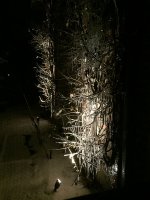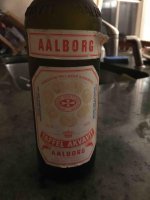Potential big snow coming to our area tonight and tomorrow. The forecasters are saying it could match the "Blizzard of 93" for our area. One to two feet of snow at higher elevations. For people north of us used to snow that may not sound like much, but for Tennessee, it will shut down the area and could take up to two weeks to restore power in some areas.
Thank you for the information, it was new to me.
But where I live, I wish it could be turned OFF. Sometimes the same message comes up several times on a single drive even.
There's no message for wet leaves on the road, there's no message for undercooled rain, there's no message for ice, there's no message for snow.
Not to mention most of the sensors around the cars beeps and throws up all kinds of errors even before the snow starts coming down, it's just droplets of water that turn to ice around the sensors, and there you have it, errors all over.
Lights blinking, beeping sounds, I've started to completely ignore them, because they hardly ever provide relevant information to the situation at hand. And I think it makes people worse at driving.
It's completely allright that people want to be careful and take their time under difficult road conditions, but maybe it's a better idea to stop on the side of the road if a line starts forming, or when trucks or work cars catch up to you, to let them pass, many have schedules to keep, and hard limits on hours behind the wheel.
... Anyway, it looks nice outside now with the snow, much brighter.
I agree, and when we start thinking our cars are going to warn us of dangers, maybe we stop thinking for ourselves.
Yes, very much so.
Seems to me people spend more time watching their blinking and beeping alerts, fiddle with buttons, and watch the speed dial more than they watch the road.
Back on track:
Had to use my Snørydder to remove some snow today, feels like it's been a while... The kids where happy to run outside with their sleds and whatnot.
Think I'm gonna have an Aquavit while they decorate the ginger bread house.
Akvavit - Wikipedia
Seems to me people spend more time watching their blinking and beeping alerts, fiddle with buttons, and watch the speed dial more than they watch the road.
Back on track:
Had to use my Snørydder to remove some snow today, feels like it's been a while... The kids where happy to run outside with their sleds and whatnot.
Think I'm gonna have an Aquavit while they decorate the ginger bread house.
Akvavit - Wikipedia
...My 11 year old Honda Element has 1st Gen drive by wire....
My 2002 Accord has a wire. Steel cable just like a motorcycle throttle/brake wire.
But electrical driving is 60 years old. From 1958---
'System uses a four-inch control lever....substitutes for steering wheel, accelerator pedal and brake pedal. ... an analog computer with d-c operational amplifiers is used .... present model uses vacuum tubes.'
Attachments
4C is when water molecules start aligning in the proper formation for ice crystals. In short, it starts getting slippery at that point. That's why the warning. And as they align, they actually get farther apart. So 4C is the most dense fresh water ever gets, and it tends to fall to the bottom or water bodies. And that's the only reason ice forms on the top of lakes and not from the bottom up (which would be disastrous). I've always thought it was a pretty fabulous system...
Moving water, as in rivers, takes longer to freeze, but the layers near the bottom move more slowly, especially in rivers with large stones on the bottom to break up the current. those rivers freeze from the bottom up, at least for the early part of the winter and in fast moving stretches. It's really quite beautiful to see the river open and flowing but the boulders on the bottom covered in blue-green ice.
Was just getting into bed last night and heard a loud bang out on the balcony. Went out to find a large icicle had dropped. It was actually warming up overnight and now we are 5 degrees and rain.
Think I'm gonna have an Aquavit while they decorate the ginger bread house.
Akvavit - Wikipedia
I have a bottle in my freezer with a very small amount leftover from my visit to Denmark to play soccer/futbol back in 1980. Maybe I'll have to finish it up tonight! Thanks for the reminder!
Moving water, as in rivers, takes longer to freeze, but the layers near the bottom move more slowly, especially in rivers with large stones on the bottom to break up the current. those rivers freeze from the bottom up, at least for the early part of the winter and in fast moving stretches. It's really quite beautiful to see the river open and flowing but the boulders on the bottom covered in blue-green ice.
Yes indeed. I learned that the bottom materials act as dust for raindrops, basically providing a substrate on which the ice can "condense" (or form). But that doesn't happen until the water is super-cooled. Not sure what temperature it starts at, but it's well below 32F/0C. And the slower movement no doubt contributes to the process. Beautiful indeed!
Empty the bottle in the sink. Guess it is way over "consume before date" ...I have a bottle in my freezer with a very small amount leftover from my visit to Denmark to play soccer/futbol back in 1980. Maybe I'll have to finish it up tonight! Thanks for the reminder!
I tried a sip a year ago or so and it was fine. But wasn't in the mood at the time. And after all, it's for sentimentality's sake... I mean, I've never really looked but I don't think it's easy to come by here in the US.
> freeze from the bottom up
Water is denser at 4C than when warmer -or- cooler.
And heat does not like to move down.
So in cold non-flowing waters, the bottom tends to be 4C, even when the top warms. This is certainly true in my swamp, pond, and ditch.
I have not seen ice bottom-up. Normally as water goes below 4C, it gets less dense and floats to the top.
Eventually the pond fills with 4C water except the top going to zero C. As mine did this week. I can't directly see the bottom (ice is not clear), but I can tell by the out-flow that it is still liquid under the ice.
In fact I have a seepage which flows in the ditch all winter except maybe a week in February. Even when the ditch is iced hard enough to walk on, turbulence over rocks leaves openings.
Water is denser at 4C than when warmer -or- cooler.
And heat does not like to move down.
So in cold non-flowing waters, the bottom tends to be 4C, even when the top warms. This is certainly true in my swamp, pond, and ditch.
I have not seen ice bottom-up. Normally as water goes below 4C, it gets less dense and floats to the top.
Eventually the pond fills with 4C water except the top going to zero C. As mine did this week. I can't directly see the bottom (ice is not clear), but I can tell by the out-flow that it is still liquid under the ice.
In fact I have a seepage which flows in the ditch all winter except maybe a week in February. Even when the ditch is iced hard enough to walk on, turbulence over rocks leaves openings.
> freeze from the bottom up
Water is denser at 4C than when warmer -or- cooler.
And heat does not like to move down.
So in cold non-flowing waters, the bottom tends to be 4C, even when the top warms. This is certainly true in my swamp, pond, and ditch.
I have not seen ice bottom-up. Normally as water goes below 4C, it gets less dense and floats to the top.
Eventually the pond fills with 4C water except the top going to zero C. As mine did this week. I can't directly see the bottom (ice is not clear), but I can tell by the out-flow that it is still liquid under the ice.
In fact I have a seepage which flows in the ditch all winter except maybe a week in February. Even when the ditch is iced hard enough to walk on, turbulence over rocks leaves openings.
Yep. But it's a different story in a flowing stream or river. If the flow is slow enough throughout it can freeze on the top. But normally the flow prevents surface ice from forming. And that allows water temps to drop substantially below freezing. Eventually, it gets so cold (like super-saturated solutions such as when you make rock candy) that the moment flow is slow enough and there's a substrate to hold onto, the ice starts forming. Normally that's on the bottom (rocks, etc.) and along the stream edge. In some cases the ice starts forming around solids in the flow, and then there's an odd slush-type formation throughout the water column. No doubt there's a lot more to this, but that's most of what I know from my days studying winter ecology and northern circumpolar regions.
I tried a sip a year ago or so and it was fine. But wasn't in the mood at the time. And after all, it's for sentimentality's sake... I mean, I've never really looked but I don't think it's easy to come by here in the US.
Mmmm. Not fabulous, but drinkable. 1980 or so!
Attachments
I tried a sip a year ago or so and it was fine. But wasn't in the mood at the time. And after all, it's for sentimentality's sake... I mean, I've never really looked but I don't think it's easy to come by here in the US.
Aquavit is available almost everywhere in the US. Easy to google a list of local stocking liqour stores.
But I would drink old wine, not as sure about how well other alcoholic beverages age.
- Home
- Member Areas
- The Lounge
- The Weather



